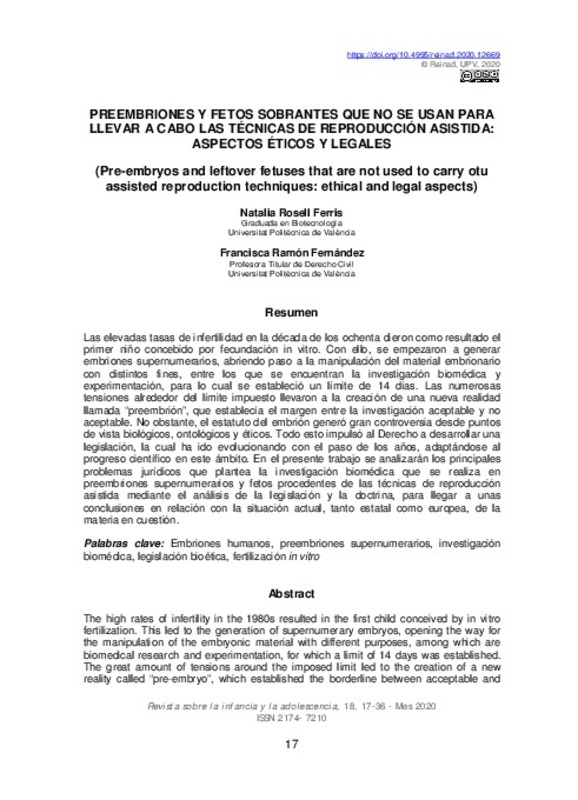- Aa. Vv. (2007). Estudio y tratamiento de la pareja estéril. Madrid: Ed. Adalia.
- Álvarez Díaz, J.A. (2010). Donación de embriones en países desarrollados. En Gaceta Médica de México, 146(3), 228-241.
- Arias, M.E. y Felmer, R. (2009). Biología de las células madre embrionarias (ES cells) en distintas especies: potenciales aplicaciones en biomedicina. En Archivos de medicina veterinaria, 41(3), 185-195.
[+]
- Aa. Vv. (2007). Estudio y tratamiento de la pareja estéril. Madrid: Ed. Adalia.
- Álvarez Díaz, J.A. (2010). Donación de embriones en países desarrollados. En Gaceta Médica de México, 146(3), 228-241.
- Arias, M.E. y Felmer, R. (2009). Biología de las células madre embrionarias (ES cells) en distintas especies: potenciales aplicaciones en biomedicina. En Archivos de medicina veterinaria, 41(3), 185-195.
- Bayat García, S. (2015). Aplicaciones farmacológicas de las células madre. Madrid: Universidad Complutense.
- Busardò, F. P. et al. (2014). The evolution of legislation in the field of Medically Assisted Reproduction and embryo stem cell research in European Union members. En BioMed research international, 1-14.
- Casado, M. (2010). En torno a células madre, pre-embriones y pseudo-embriones: el impacto normativo de los Documentos del Observatorio de Bioética y Derecho de la UB. En Revista de Bioética y Derecho, 0(19), 17-32.
- Cavaliere, G. (2017). A 14-day limit for bioethics: the debate over human embryo research. En BMC medical ethics, 18(1), 38-50.
- De La Garza, C. (2014). Fertilización. El inicio de una nueva vida", en Embriología humana y biología del desarrollo (pp. 69-82). México: Ed. Médica Panamericana.
- Ferrer Colomer, M. y Pastor García, L. (1998). Génesis y uso del término "pre-embrión" en la literatura científica actual. En Persona y bioética, 2, 2-27.
- Ferrer Colomer, M. y Pastor García, L. M. (2012). The preembryo's short lifetime. The history of a Word. En Cuadernos de Bioética, 23(79), 677-694.
- Godoy Vázquez, Mª. O. (2014). Régimen jurídico de la tecnología reproductiva y la investigación biomédica con material humano embrionario. Madrid: Dykinson.
- Grobstein, C. (1979). Fertilización humana externa. En Scientific American, 240(6), 57-67.
- Huguet, P. (2004). Clonación humana: Aspectos bioéticos y legales. Madrid: Universidad, Universidad Complutense de Madrid.
- Lacadena, J. (2002). Genética y bioética. Bilbao: Ed. Desclée de Brower.
- Laustriat, D., et al. (2009). Les cellules souches embryonnaires et la pharmacologie. En: Medical Sciences, 25(1), 32-38.
- Liang, P., et al. (2015). CRISPR/Cas9-mediated gene editing in human tripronuclear zygotes. En Protein Cell, 6, 363-372.
- Mcleod, C. V. y Baylis, F. (2007). Donating fresh versus frozen embryos to stem cell research: in whose interests?. En Bioethics, 21(9), 465-477.
- De Sutter, P. et al. (1996). Oocyte morphology does not correlate with fertilization rate and embryo quality after intracytoplasmic sperm injection. En Human Reproduction, 3, 595-597.
- Pennings, G. (2007). Belgian Law on Medically Assisted Reproduction and the Disposition of Supernumerary Embryos and Gametes. En European Journal of Health Law, 14(3), 251-260.
- Shalev, C., y Werner-Felmayer, G. (2012). Patterns of globalized reproduction: Egg cells regulation in Israel and Austria. En Israel journal of health policy research, 1(1), 15-27.
- Vidal Casero, M. del C. (2001). La experimentación con embriones/feto. En Revista Bioética y Ciencias de la Salud, 4(2), 1-21.
- Walsh, D. J., et al. (2011). The evolution of health policy guidelines for assisted reproduction in the Republic of Ireland, 2004-2009. En Health Res Policy Syst, 9(1), 28-33.
- Warnock, M. (1985). Moral thinking and government policy: the Warnock Committee on Human Embryology. En The Milbank Memorial Fund Quarterly. Health and Society, 63(3), 504-522.
- Wilson, C. et al. (2010). Effect of the length of time that donated embryos are frozen on pregnancy outcome. En Clinical and Experimental Obstetrics & Gynecology, 37(3),181-182.
- Zegers-Hochschild, F. et al. (2009). The International Committee for Monitoring Assisted Reproductive Technology (ICMART) and the WorldHealth Organization (WHO) revised Glossary of ART Terminology. En Fertility and Sterility, 92(5), 1520-1524.
- Zhou X., et al. (2015). Generation of CRISPR/Cas9-mediated gene-targeted pigs via somatic cell nuclear transfer. En Cellular and molecular life sciences, 72(6), 1175-1184.
[-]









